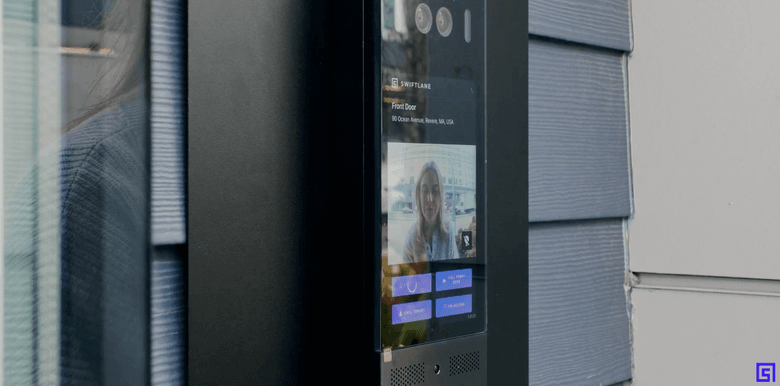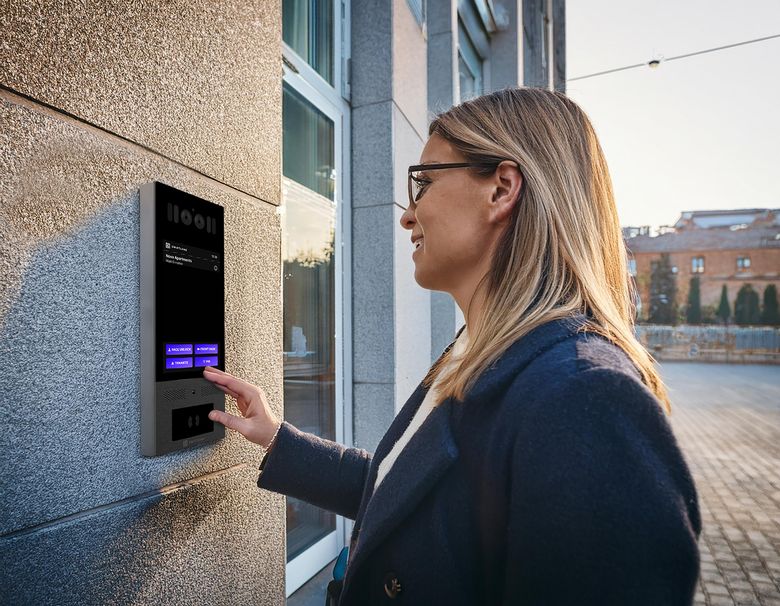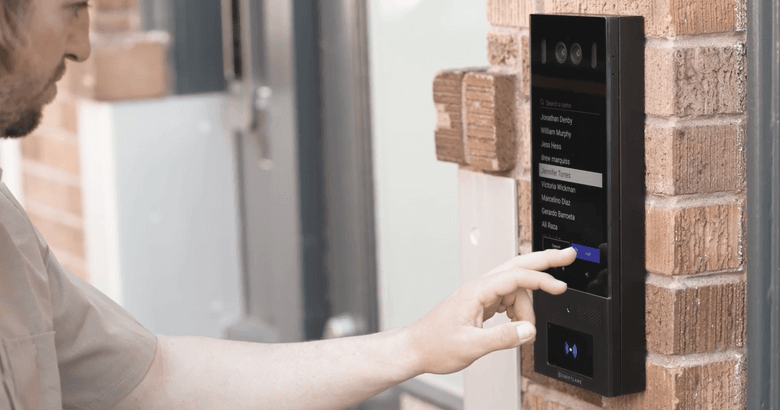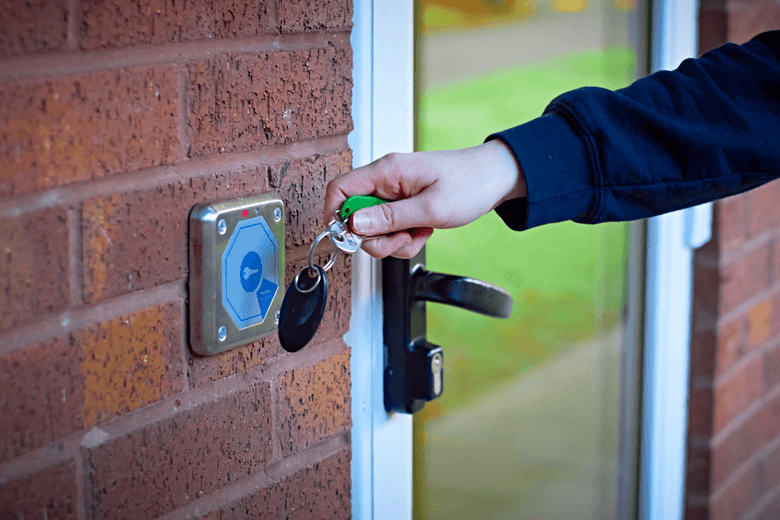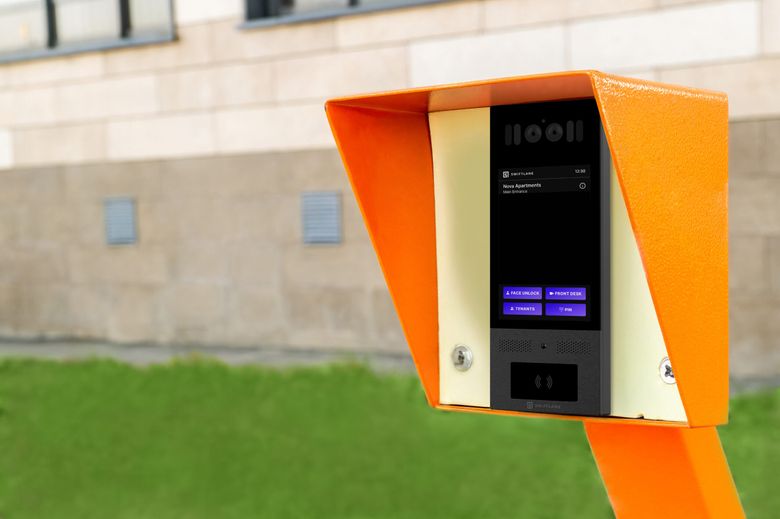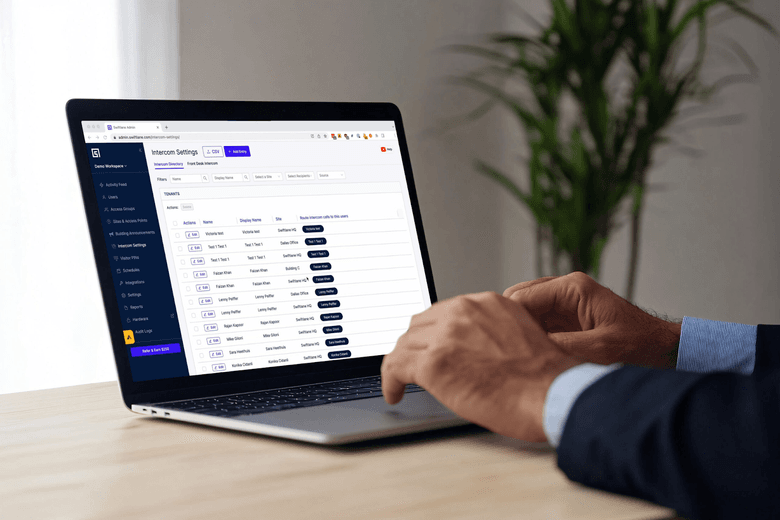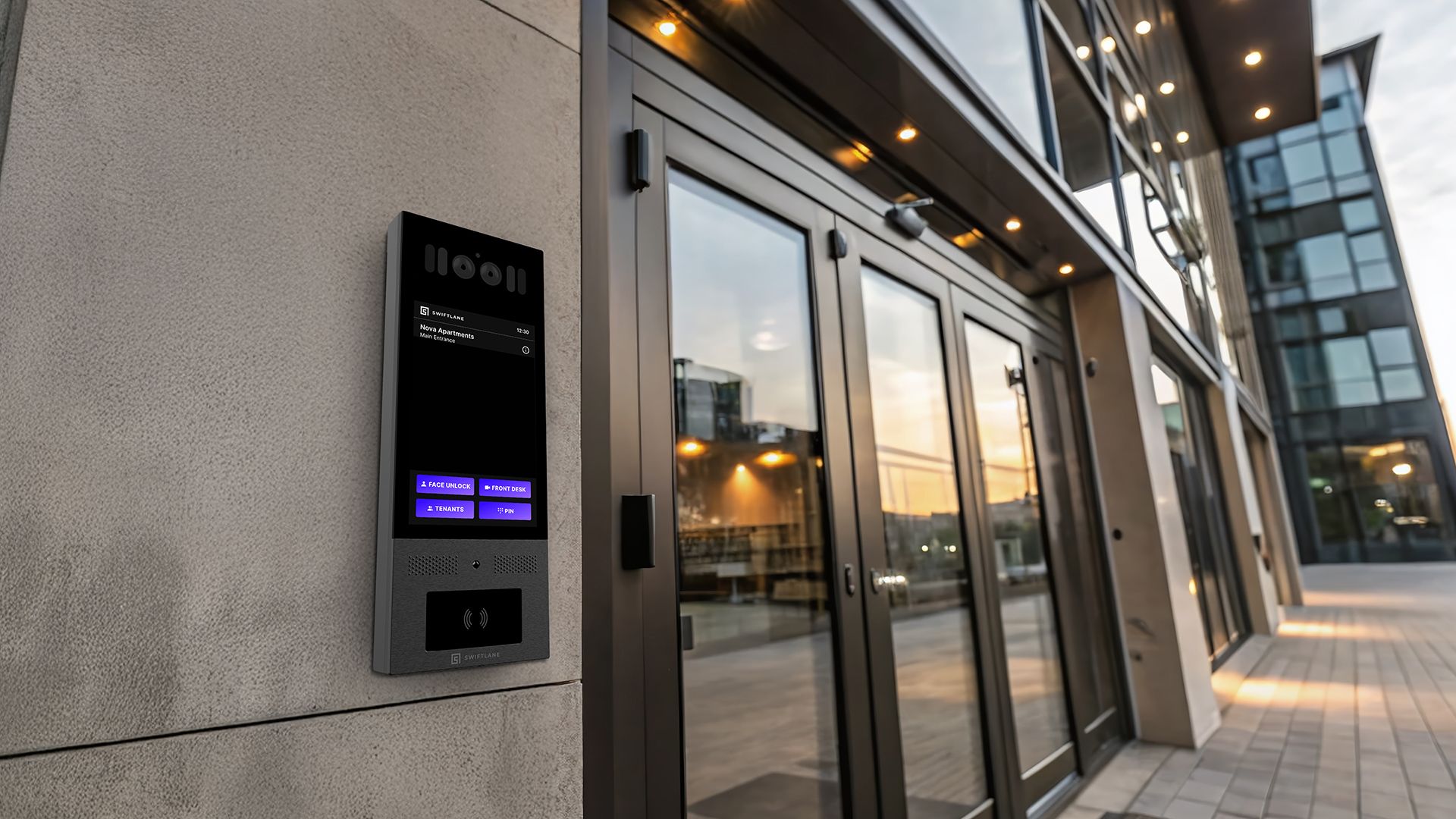We’ve set out to create a one-stop shop with everything you need to know when buying an apartment intercom system. Are you the owner or property manager of a multi-unit rental building? Or perhaps you’re a condo, co-op, or HOA board member looking for an access control solution for your community? You may also be a residential developer seeking ways to add property value to your final product. If your answer to any of these is yes, this is your guide.
We designed this guide to help you make a smart and informed decision on an intercom system that can suit your building for years to come. We cover everything you need to know, including:
- The basics – what is an intercom, and what are they for?
- Key intercom features and system types
- Installation basics
- Cost considerations
- How these systems enhance residential buildings
Whether you’re managing an intercom upgrade or starting from scratch, this comprehensive overview will give you the clarity and confidence to choose the best intercom system for your building.
Table of Contents
- What is an Apartment Intercom System?
- Why Upgrade Your Intercom System?
- Main Intercom Types
- Key Intercom Features
- What Do Intercoms Cost?
- What’s the Bottom Line on Apartment Intercoms?
- Consider a Swiftlane Apartment Intercom System
Suggested Posts
- Best Intercom Systems (2025) – Top Picks for Every Type
- Smart Intercom System: Benefits, Overview and Top Picks
- Biometric Access Control: What It Is and Why You Need It
- Cheap Intercom System for Residential and Commercial Uses
What is an Apartment Intercom System?
An apartment intercom system is the collection of hardware and software that can connect visitors at the front door of a residential building with the building’s occupants. An evolution beyond doorbells and apartment buzzers, an intercom lets visitors and residents speak to each other live. That way, residents know who is at the door before pressing a door release button. Today’s modern systems include access control. The intercom is connected to an electronic door lock so that the resident can unlock the door remotely without going to the front door.
Today, residential buildings see more foot traffic than ever. Residents’ friends and family are just the start. The explosive growth of food and package delivery sees buildings experiencing numerous daily visitations.
Layer on top of that all the help that people hire: childcare workers, pet care, cleaning people, tutors… it all adds up. Modern intercom systems help your residents manage all this traffic while keeping themselves and the building safe and secure.
Components of a Typical Apartment Intercom System
Door Intercom
This is the hardware the visitor uses to “call” a resident of the apartment, co-op, or condo building. Apartments typically have one intercom at the front door, but may have additional intercoms at other doors or gates into parking areas. Other types of residential communities, such as an HOA, may also have an intercom at the main gate to the community.
Power Source
The intercom system needs power. Power supplies vary depending on the intercom hardware and use case:
- Batteries – typical for basic intercom systems for single-family homes
- An ordinary plug and socket
- Hardwired into the building’s standard 110V electrical
- Low voltage power, such as from a DC power transformer or Power over Ethernet (PoE).
Tenant Device
The tenant needs a way to receive calls from the intercom.
- Some older audio intercom systems, known as “call boxes,” route the call to the tenant’s telephone number like an ordinary phone call.
- With “wired intercoms,” the intercom is connected by wire to a special receiver unit, sometimes called an intercom receiver or intercom viewer, inside each unit.
- Modern systems, broadly categorized as “wireless intercoms” route the call to the Internet, from where it can connect to the resident’s smartphone or digital device so the resident can take the call from anywhere and include live video.
Electronic Door Lock
Most intercom systems are connected to an electronic door-locking mechanism. When the resident gives the system permission by pressing a button on their phone, smartphone, or intercom viewer, the door unlocks for the visitor.
Other Features
Today, many intercoms include various additional features. These include video, internet connectivity, multiple access control credentials, online management platforms, weatherproof and anti-vandal casings, and more, which we outline in further detail below.
Why Upgrade Your Intercom System?
When you install a comprehensive intercom system with modern features, your building gains a variety of benefits for residents, property management staff, and the building owner.
Resident Benefits
- Security and Safety
- Easily screen and identify visitors.
- Reduce unauthorized entry and enhance personal safety.
- Convenience
- Remotely unlock doors from inside apartments or via smartphone apps.
- Simplified guest access through temporary codes or virtual keys.
- Improved Communication
- Reliable communication channel with visitors or delivery personnel.
- Minimized missed deliveries and visitor confusion.
- Privacy
- Residents control visitor access, ensuring fewer unexpected interruptions.
- Digital directories protect resident privacy through optional anonymity.
Property Management Benefits
- Streamlined Operations
- Tenants manage guest/delivery access, helping manage high traffic volumes without dedicated staff.
- Easier handling of move-ins/move-outs by updating digital directories and digital access keys remotely.
- Enhanced Security Management
- Monitor visitor entry and exit via access logs and audit trails.
- Easier identification and resolution of security issues.
- Reduced Operational Costs
- Reduced reliance on concierge/security personnel for basic entry management.
- Electronic systems lower administrative effort and time.
- Integration Capabilities
- Many intercoms integrate with existing security cameras, elevators, and property management software.
- Simplified overall management through centralized control systems.
Building Owner Benefits
- Increased Property Value
- Enhanced security and modern amenities attract and retain tenants.
- Contributes positively to property marketability.
- Reduced Risk and Liability
- Improved security measures help mitigate risks associated with unauthorized access and can lower insurance costs.
- Electronic records of visitor access reduce liability concerns.
- Cost Efficiency
- Reduced staffing costs due to automated and resident-operated systems.
- Lower long-term operational costs compared to traditional access control.
- Attraction and Retention
- Modern intercom systems attract higher-quality tenants willing to pay a premium.
- Improved tenant satisfaction leads to higher occupancy rates and lower turnover.
- Improved NOI
- By reducing staffing costs and increasing occupancy and rents, a modern apartment intercom system can help property owners improve net operating income (NOI).
Main Intercom Types
In recent years, the number of different intercom types, models, and features has exploded.
We wrote this section to help you understand all the options available.
Audio-only vs. Video Intercoms
Audio-only Intercoms
For decades, audio intercoms were the standard intercom format. They used to let a guest or visitor at the front door speak with a resident. Audio intercoms can be:
- Full-duplex: Both parties can talk at the same time, just like a telephone call.
- Half-duplex: Only one party can talk at a time, more like a walkie-talkie.
- Simplex: Uncommon for a building intercom, audio only goes in one direction. These are more common in retail, commercial, and institutional settings.
Advantages: Can be cheaper, with minimal maintenance.
Disadvantages: Less secure (visitor identity verification limited), no visual confirmation. Telephone lines for call boxes can be expensive.
Call Boxes
Apartment call boxes are a specific kind of audio intercom that works with the telephone system. The phone number for each tenant is programmed into the intercom.
When a visitor selects the apartment from the on-screen directory, the intercom places a phone call, usually over a traditional landline, to the tenant. In everyday language, many people use the term “call box” and “intercom” interchangeably whether the telephone system is used or not.
Video Intercoms
Increasingly popular in the twenty-first century, video intercoms let residents see who is really at the door. The mere presence of the intercom camera deters would-be criminals from pretending to be someone else.
Video intercoms can be one-way or two-way. With a two-way video intercom, both the resident and visitor can see each other live. This is done usually at the discretion of the resident, who can toggle this option on or off.
Video intercoms can include a wide array of optional features. These can be high-definition (HD) cameras, low-light or night-vision modes, built-in floodlights, facial recognition, and face ID anti-spoofing technology.
Advantages: Increased security through visual identification, enhanced visitor screening, and improved resident convenience.
Disadvantages: Usually a modestly higher initial investment. Wired video systems require additional tenant hardware, while most wireless systems don’t.
Internet Protocol Intercoms
IP intercom systems use internet networks to enable secure audio and video communication between entrances and occupants. This offers a modern alternative to traditional analog systems. These systems typically connect via Ethernet or Wi-Fi and allow users to manage access remotely using smartphones or computers. Key benefits include high-quality video and sound, the ability to scale across multiple entry points or buildings, and integration with other security tools like cameras and alarms. For consumers, this means more control, convenience, and improved safety—whether for residential, commercial, or institutional use.
Credential Types for Residents
Depending on the apartment intercom system, residents can use various credential types to access entry points. We provide a quick overview here, and further details on each below.
- Physical Keys: Residents just stick their key in the door the old-fashioned way. Often used as backup, but subject to key leakage (unauthorized copies, key management, etc.)
- PIN Codes: Traditional intercom access method that is reliable but lower security (PINs can be shared with non-residents contributing to unauthorized entries).
- Key Fobs and RFID Cards: Easy to use, more secure, and trackable. However, they can be shared or copied.
- Smartphone-based Credentials: App-based mobile keys (Bluetooth or Wi-Fi), highly secure and convenient.
- Biometric Access: Fingerprint or facial recognition—high security and can only be used by the authorized tenant. Face ID is often preferred as a touchless, hands-free entry method.
How Authorized Guests Get Access
An apartment intercom system often includes special ways of letting in visitors, guests, service workers, and deliveries separate from the tenant’s access control credentials. These entry methods include:
- Remote Unlock: Residents can grant entry remotely by pressing a button on smartphone apps or in-unit intercom stations.
- Temporary Access Codes: Pre-generated codes (PINs or QR codes) sent to guests for one-time or scheduled use.
- Virtual Keys: App-based access keys sent digitally to guests’ smartphones.
- Concierge or Remote Management: Concierge/security personnel grant entry after verifying the visitor’s identity.
Types of Intercom Directories
For multitenant buildings, the intercom needs to be paired with a tenant directory so that guests know how to call each resident.
- Printed Directory: Traditional printed lists of residents’ names and unit numbers—simple, cost-effective, but difficult to update and old-fashioned.
- Pushbutton directory: The intercom has an individual button for each unit. Tried and true, but it doesn’t scale to large buildings.
- Electronic/ Digital Directory: Digital display of residents’ names that show up on the intercom screen. They’re easily updatable remotely. Modern models use touchscreens with a search feature, which is more convenient for users.
- No Directory (Private System): Residents grant access directly to known visitors, maximizing privacy and security.
Pushbutton vs. Touchscreen Intercoms
- Pushbutton Intercoms: Once ubiquitous, these older intercom designs have physical pushbuttons such as a button for each apartment or a telephone-style keypad for selecting apartments by number or letter.
- Advantages: Robust, easy to operate, suitable for harsh environments, lower cost.
- Disadvantages: Limited features, less intuitive, fixed physical directory, harder to update.
- Touchscreen Intercoms: In today’s era of ubiquitous smartphones and low-cost touch screens, today’s modern intercoms often have a built-in touch screen that allows for dynamic buttons, searchable directories, and even two-way video.
- Advantages: Interactive, customizable interfaces, easy directory updates, modern design.
- Disadvantages: Higher cost, potential durability issues in outdoor settings (see IP and IK ratings below), requires electricity and data connections.
Key Intercom Features
Intercoms come with a very wide array of options. Here we explain what these features provide.
Apartment Intercom System with Door Release
This is perhaps the most common and important feature for an apartment intercom to have. An apartment intercom system with door release allows residents to remotely grant access to visitors. This is done by unlocking the building’s entrance through various mechanisms such as electric strikes, magnetic locks, or motorized deadbolts.
Modern intercoms can be wired or wireless and often integrate with mobile apps for added convenience, allowing door control from smartphones – also known as remote access control or mobile access control. Choosing the right system involves considering compatibility with existing infrastructure, ease of installation, reliability, and cost-effectiveness. Upgrading to such a system enhances security, improves resident experience, and streamlines visitor management in multi-tenant buildings.
Keyless Entry
Keyless entry systems for apartments are electronic access control solutions that eliminate the need for traditional physical keys. Instead, residents can gain entry using methods such as PIN codes, mobile apps, or biometric identifiers like facial recognition or fingerprints or newer palm vein technology. These systems enhance security by reducing the risk associated with lost or duplicated keys and offer greater convenience for residents. They also streamline property management by allowing for easy addition or revocation of access permissions without the need to change locks. Keyless entry can be implemented at various access points within an apartment complex, including main entrances, individual units, elevators, and garages, providing a comprehensive and modern approach to building security and resident convenience.
Face Recognition Access Control
Facial recognition access control is a modern, touchless security solution that uses biometric technology to verify a person’s identity by scanning their face. It eliminates the need for key cards, PINs, or phones, offering a faster, more secure, and more convenient way to access buildings. The system works by capturing a facial image, matching it to encrypted biometric data, and granting or denying access in real time.
This method reduces the risk of credential theft or misuse. Advanced systems like Swiftlane’s also include anti-spoofing features to prevent fraud using photos or videos. Ideal for workplaces, residential buildings, and high-security areas, facial recognition access provides a seamless entry experience while enhancing safety and hygiene.
Fob Systems
Key fobs are one of the most common access control credentials that work with intercoms. Key fob systems work using radio frequency identification (RFID) a radio communication tool that works at short distances between the intercom or a proximity reader and the key fob itself. The key fob contains a unique code that signals to the intercom to release the door. While this has been a common apartment credential for decades, key fobs can be copied by unauthorized agents, and unlike some other forms of credentials they can be lost or stolen.
Keycard Access Control
Working using the same RFID communications method as key fobs, keycard access control used rectangular ID badges that fit in a normal wallet instead of key fobs. Keycards are most popular in settings where people are issued an ID badge, such as commercial buildings, hospitals, and student/university housing.
Mobile Access Control
Mobile access control allows users to unlock doors using smartphones, tablets, or wearables instead of traditional key cards, offering a more secure, convenient, and hygienic way to manage entry. It reduces the risk of lost or stolen credentials and supports advanced security features like two-factor authentication and encrypted data transmission. Technologies like Bluetooth Low Energy and NFC enable touchless access, often without needing to remove a phone from a pocket or bag. Mobile access systems can also support remote credential management, presence detection, and mass notifications—making them ideal for modern workplaces, residential buildings, and commercial properties seeking smarter, more flexible security solutions.
QR Code Credentials and Intercoms
QR Codes have two uses in intercom systems: as a credential and as a link to an online directory. With some video intercom systems, residents can send a unique QR code to their visitors, guests, or delivery people via text or email. The QR codes can be one-time use or time-limited. The visitor displays the QR code on their mobile device and holds it up to the intercom camera. The intercom detects the code and unlocks the door.
Some apartment intercom systems are “virtual” and use a QR code mounted at the building entrance instead of electronic hardware. Visitors simply scan a QR code displayed at the entrance, which opens a virtual directory on their smartphone, enabling them to initiate a video call with residents from their own smartphone.
Vehicle Access Control
Vehicle access control systems for apartments with parking areas or garages manage and automate the entry and exit of cars into restricted areas, ensuring only authorized vehicles are allowed in. These systems use technologies like RFID tags, license plate recognition (LPR), mobile apps, voice commands, and even biometric verification to authenticate drivers or vehicles. As a car approaches, the system verifies credentials—whether through a tag on the windshield, a license plate scan, or a smartphone signal—and automatically opens gates or barriers if access is granted. These systems can be integrated with an intercom at the vehicle gate so that visitors can request access. This not only enhances security by preventing unauthorized entry but also improves traffic flow and convenience, reducing the need for manual checks. Additionally, access events are logged for monitoring and audit purposes, making these systems ideal for residential complexes, commercial parking lots, and high-security facilities.
Voice Enabled Unlock
Voice-enabled door unlock systems let users open doors, gates, or garages using simple voice commands through a smartphone’s virtual assistant—like Siri, Google Assistant, or Alexa. These systems work by integrating voice commands with a mobile access control app, often using shortcuts or custom routines. When the user is near the entry point, they can say a pre-set command (e.g., “Unlock the front door”) to trigger the app to send a secure signal to the access control system. The system then verifies the user’s identity and unlocks the door if authorized. This hands-free method is especially useful for convenience, accessibility, and situations where a person’s hands might be full. Voice-enabled unlocks typically rely on Bluetooth, WiFi, or cellular connectivity and are most commonly used in modern smart building environments.
Cloud-Based Access Control
Cloud-based access control systems, a common option for IP intercom systems, represent a modern approach to managing physical security by leveraging internet connectivity and centralized management. These systems enable administrators to control and monitor access to buildings or specific areas remotely, using web-based dashboards or mobile applications. Unlike traditional on-premises systems that require local servers and manual updates, cloud-based solutions offer automatic software upgrades, scalability across multiple locations, and reduced hardware costs. This architecture enhances flexibility, allowing for quick adjustments to access permissions and improved responsiveness to security incidents, making it particularly suitable for dynamic environments like offices, residential complexes, and commercial properties.
Weatherproof Intercom
Some intercoms are only designed for indoor mountings, while others are sealed against even the most extreme weather or floods. The ingress protection (IP) rating tells you the intercom’s resistance to dust and water. The first digit of the rating can range from 0 (no protection against dust) to 6 (completely sealed against dust). The second digit of the rating can range from 0 (no protection against water) to 9 (protected against full submersion in water under pressure). We suggest IP65 or higher for outdoor mountings. Water protection of level 5 and up would be sufficient for anything but a flood or a fire hose.
Vandal-proof Intercom
Intercoms can be a significant investment in modern digital hardware – one that no building owner wants to see damaged by either an accident or intentional vandalism. Intercoms can be certified against various levels of kinetic energy (aka impact) on the IK scale from 01 to 10. An IK10 rated intercom can have a baseball bat taken to it without damage due to the hardened casing. IK10 is a great choice for dense urban environments when the intercom is mounted outside.
What Do Intercoms Cost?
Intercoms can range widely in price from around $200 for the most basic system suited to a single-family home to upwards of $5,000 for certain brand-name models for large buildings. In our experience, price is not always an indicator of quality, nor is it even directly tied to the number of features. A wide array of cheap intercom models is available, especially for smaller buildings.
A large apartment building may want a budget of around $2,500 for a comprehensive modern wireless video intercom system that can handle dozens of units. However, these investments can easily pay for themselves in reduced property management costs by replacing legacy keys, reducing lobby staff needs, reducing theft, and improving insurance rates.
Considering only the intercom hardware costs can be misleading if there are complicated and lengthy processes to install it. Some battery-powered intercoms, typically designed for single-family homes, can be installed as DIY projects, or by a handyman for a few hundred dollars. Comprehensive systems for multi-tenant buildings typically cost at least $1000 because they require a professional security systems integrator to install. Beware that a wired intercom system may cost significantly more because an electrician or IT professional will have to run wires from the front door to all the apartments in the building.
Additional Intercom Cost Considerations:
Beyond the hardware costs for the intercom itself, there are additional cost considerations before you will have a fully function intercom system.
- Intercom Users– Wired intercoms use dedicated intercom viewers in each unit of the apartment building to connect to the front door intercom. These will bring an additional cost that rises in proportion to the number of units.
- Back-end Hardware – Wired intercoms may require intermediary hardware such as ethernet switches and door control hubs to connect all the equipment.
- Connectivity Fees – Wireless intercoms and those with cloud-based platforms have to connect to the Internet. They can connect to a building’s existing Wi-Fi network or plug into a modem via Ethernet, or a cellular data provider (LTE or 5G). The Internet service comes with usual monthly fees. Older “call boxes” often require a landline telephone line, which can be pricey.
- Service Fees – Intercoms with a cloud-based service platform and app usually have a small monthly fee of a few dollars per month for each apartment unit in the building.
Also Consider
- Ongoing support: Does the intercom include live 24/7 technical support directly from the manufacturer. This is most common among IP intercoms with cloud based management, where the manufacturer can directly log into the hardware and troubleshoot the system.
- Warranty: Does the intercom come with a warranty against defects and errors?
- End-User Satisfaction: An intercom system is not a great investment if resident end up hating the system. One place to start is by checking the ratings of an intercom’s app – where applicable – on the Apple App and Google Play app stores. Residents generally only give high marks to an app if they like how the system works overall.
What’s the Bottom Line on Apartment Intercoms?
An apartment intercom system is a modern access and communication tool that connects visitors at a building entrance with residents, offering both security and convenience. These systems have evolved far beyond traditional buzzers, now often including video, mobile access, and remote door unlocking features. For residents, they improve safety, make visitor management easier, and support touchless, app-based access. Property managers benefit from streamlined operations and lower staffing costs, while building owners see increased property value and tenant satisfaction. Whether you’re upgrading an old system or installing one from scratch, today’s intercoms offer scalable solutions for buildings of all sizes—with a wide range of features, access credentials (like fobs, mobile apps, and facial recognition), and cost options to match your needs and budget.
Consider a Swiftlane Apartment Intercom System
Swiftlane apartment intercom systems offer a modern, secure, and user-friendly access control solution designed to meet the needs of today’s multifamily buildings. With cloud-based infrastructure, mobile access, and video calling, Swiftlane allows property managers to streamline entry management while enhancing the resident experience. Its sleek hardware, intuitive software, and advanced authentication methods reduce operational hassles, improve building security, and add long-term value to any residential property.
Key Features
- Face recognition entry for tenants, with encrypted facial data storage
- Touchless access to reduce contact and enhance hygiene
- Cloud-based system with remote management and automatic software updates
- Mobile app for residents to unlock doors with their smart devices
- Works with new or existing key fob systems
- High-definition video calling for visual verification of guests
- Secure visitor access via QR code or PIN
- Works with existing electronic locks and electric strikes
- Built-in access logs for audit trails and incident tracking
- Modern touchscreen directory for easy guest calling
- Scalable for buildings of all sizes, from small walk-ups to high-rises
- IK10 and IP65 certified for durability
- 2-year manufacturer warranty
Still have questions?
Tell us about your building and we’ll help you find the best solution.
